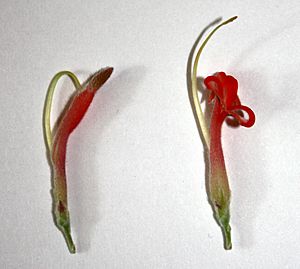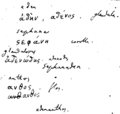Adenanthos facts for kids
Quick facts for kids Adenanthos |
|
|---|---|
 |
|
| A flower and leaves of the Coastal Jugflower (A. cuneatus), which is the main example for the Adenanthos group. | |
| Scientific classification |
|
| Kingdom: | Plantae |
| Clade: | Tracheophytes |
| Clade: | Angiosperms |
| Clade: | Eudicots |
| Order: | Proteales |
| Family: | Proteaceae |
| Subfamily: | Proteoideae |
| Tribe: | Leucadendreae |
| Subtribe: | Adenanthinae |
| Genus: | Adenanthos Labill. |
| Type species | |
| Adenanthos cuneatus Labill.
|
|
| Species | |
|
|
Adenanthos is a group of native shrubs found in Australia. These plants belong to the flowering plant family called Proteaceae. What makes them special is that they usually have single flowers, which is rare for this plant family.
The Adenanthos genus was first found in 1791. It was officially described by Jacques Labillardière in 1805. The main example species for this group is the Coastal Jugflower (Adenanthos cuneatus). There are 33 known species in total.
These plants are only found in Australia. Most of them (31 species) grow in southwest Western Australia. The other two species are found in South Australia and western Victoria (Australia). Birds are the main helpers for pollinating these plants.
Contents
What do Adenanthos Plants Look Like?
How do Adenanthos Plants Grow?
Adenanthos plants can grow in different ways. Some are low-growing shrubs that spread along the ground. Others are upright shrubs, and some can even become small trees.
Plants that have a single main stem usually grow into tall, upright shrubs. Sometimes, this main stem gets very thick and forms a small trunk, making it look like a tiny tree.
Other Adenanthos plants have many stems growing from an underground root system called a lignotuber. These usually stay as smaller shrubs and have a bushy, multi-stemmed shape, often called a mallee habit.
The Unique Leaves of Adenanthos

Just like many plants in the Proteaceae family, Adenanthos leaves come in many different shapes. Even though their leaves are always simple (meaning they are not made of smaller leaflets), they can be lobed or deeply divided. Often, they split into three parts.
A very special leaf shape is found in plants known as woollybushes. Their leaves are divided many times into long, thin, round segments. These segments are often covered in soft, fine hairs, making them feel woolly. The number of these segments can vary a lot. For example, A. pungens might have whole leaves or just two or three segments. But A. sericeus can have leaves divided into as many as 50 tiny segments. About half of all Adenanthos species have this woollybush leaf type.
Other common leaf shapes include wedge-shaped leaves with small lobes at the tip, like those of the Coastal Jugflower (A. cuneatus). Some have oval-shaped leaves, such as A. obovatus. There are also species with long, thin leaves, like A. detmoldii. Only two species have sharp, pointed leaves. A. pungens has woollybush leaves with sharp tips, and A. acanthophyllus has flat, deeply lobed leaves with sharp edges.
Some people say that certain Adenanthos leaves have tiny nectar glands at their tips.
Flowers of Adenanthos

Unlike most plants in the Proteaceae family, Adenanthos flowers usually grow one by one, not in big bunches. Each flower grows at the end of a short stalk. At the base of the flower, there are small, overlapping leaf-like structures that surround it. Very rarely, these structures might hold two flowers instead of one.
Flowers can grow at the very end of a branch or where a branch meets the main stem. In most species, the flowers are hidden by the leaves. However, species with flowers growing where branches meet the stem tend to be more noticeable.
The structure of an Adenanthos flower is similar to many other Proteaceae plants. Flower parts usually come in groups of four. The four petals are joined together to form a long, narrow tube, which ends in a closed cup. The pollen-producing parts (stamens) are attached inside this tube. The female part of the flower (pistil) is also trapped inside the cup at first. Four small, scale-like glands that produce nectar are found around the base of the pistil.
Most Adenanthos flowers are radially symmetrical, meaning they can be divided into equal halves in any direction. But in a small group called Eurylaema, one stamen is not fertile, making the flowers only bilaterally symmetrical (like a mirror image). As the pistil grows, it pushes its way out of the flower tube, causing the flower to bend.
The tip of the pistil, called the style-end, does two jobs. It collects pollen, like a normal stigma. But it also acts as a pollen-presenter. When the flower is ready, the pollen is released onto the style-end while it's still inside the flower. Then, the flower opens, and the style-end springs out, holding the pollen up. This makes it easy for nectarivorous birds to pick up the pollen when they visit the flower for nectar. The style-end of Adenanthos is usually cone-shaped or oval.
Fruits and Seeds
The fruit of Adenanthos is a small, dry, hard-shelled nut. It holds the seed inside but doesn't stick to it. These fruits are brown, oval-shaped, and usually 3 to 8 mm long. You don't often see them on the plant because they grow hidden inside the flower's protective structures.
Once the fruit is ripe, these protective structures dry out and open, allowing the fruit to fall to the ground. In some species, this happens right away. In others, the fruit stays on the plant for a while.
Sometimes, Adenanthos plants produce fruits without seeds. Also, seeds can sometimes fail to develop properly. When a seed is present, it's white, oval, and almost fills the fruit.
Where do Adenanthos Plants Live?
Most Adenanthos species (31 out of 33) are found only in southwest Western Australia. This area is the main home for these plants. The south coast of Western Australia, especially between the Stirling Range and the Fitzgerald River area, has many different species. Seventeen species grow just on the Esperance Plains. This region is known for its rich variety of plants and many unique species.
Adenanthos plants grow throughout most of the southwest region. In northern areas, they don't grow in the drier inland parts. However, further south, they can be found well inland, even reaching into the desert. For example, A. argyreus grows as far inland as Southern Cross.
Along the south coast, you can find Adenanthos in separate groups on sandy patches. These patches are surrounded by different types of soil. The furthest east they grow in Western Australia is at Twilight Cove.
The two species that live outside southwest Western Australia are Adenanthos macropodianus (Kangaroo Island glandflower), which is only found on Kangaroo Island, and Adenanthos terminalis (yellow glandflower). A. terminalis grows in South Australia on the Eyre Peninsula and Kangaroo Island, and also from Adelaide eastwards into western Victoria.
How Adenanthos Plants Interact with Nature
Many types of honeyeater birds have been seen feeding on Adenanthos flowers. These include the Eastern Spinebill, Little Wattlebird, Crescent Honeyeater, New Holland Honeyeater, Tawny-crowned Honeyeater, Silvereye, and Brown-headed Honeyeater.
One study found that birds spent more time feeding where there were many Banksia sessilis plants. Even though the amount of Adenanthos didn't seem to affect how long birds stayed, these birds still visited and fed from Adenanthos flowers. This shows that Adenanthos plants are an important food source for these birds.
Images for kids
-
A close-up of a branch tip of the Common Woollybush (A. cygnorum).
-
The Scott River Jugflower (A. detmoldii).
-
Notes on the original A. cuneatus plant sample, showing how the name Adenanthos was created.
See also
 In Spanish: Adenanthos para niños
In Spanish: Adenanthos para niños




